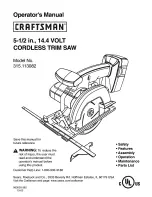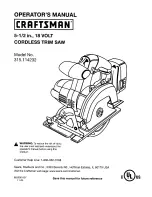
English
◌
Set the blade angle to 0°.
◌
Raise the saw blade to maximum height by turning
height adjusting knob clockwise.
◌
Lock the blade by turning bevel lock lever clockwise.
◌
Place the riving knife in the highest position.
◌
Pull out and hold knob (47) and push anti-kickback pawls
up, remove it from the anti-kickback pawls storage (31)
located on inside of the left side of saw. (Fig. 8a)
◌
Pull out and hold knob (47). Align slot in anti-kickback
pawls (1) over the slot A (48) indicated of riving knife (2).
Place the spring pin (49) on the anti-kickback pawls (1)
into the slot (A) (48) indicated on the riving knife (2).
◌
Press anti-kickback pawls (1) down until it snaps into
place and release knob (47) to insert the pin (50) into
hole (51) indicated on the riving knife (2).
CAUTION
Pull up on anti-kickback pawl assembly to make sure it is
secured to riving knife.
WARNING
Gently pull up the anti-kickback pawls to ensure it is locked
into place. Make sure that the anti-kickback pawls move
freely and are not stuck in the table insert slot.
WARNING
Use extra caution when cutting wood products having
slippery surface as the anti-kickback pawls may not always
be effective.
8. Blade guard installation (Fig. 9a-9c)
WARNING
KEEP GUARDS IN PLACE and in good working order for
all through cut operations. Reinstall the blade guard
immediately after finishing any non-through cut operations
which require removal of the blade guard. Failure to heed
this instruction could result in serious personal injury.
◌
Turn off the saw and remove the battery pack.
◌
Hold the knobs (52) (one on either side of the blade
guard) and push the knobs forward to the front of the
blade guard and up until the pin comes out from the slot
in the mounting bracket (blade guard storage) (32) at
bottom front right side of the saw, then remove the blade
guard from the U-bracket (blade guard storage) (32) at
bottom middle right side of the saw (Fig. 9a).
◌
Hold and push knobs (52) forward to the front of the
blade guard. Place the pins (53, 54) on the blade guard
(23) into the slot B (55) and slot C (56) indicated on the
riving knife (2). (Fig. 9b)
◌
Pull blade guard fully back onto riving knife. Push pin
and release it to lock guard into position.
◌
If blade guard is not parallel to table when riving knife is
in uppermost position (through cuts), adjust the set
screw (57) as necessary. (Fig. 9c)
WARNING
After the installation, check the blade guard to ensure
that it is properly placed and workable before operation
the saw.
WARNING
When using the blade guard, lift the left and right blade
guard and make sure that they move independently and
contact the table surface. The blade guard can be raised
to adjust the cut line, but must be lowered to contact the
table surface before starting the saw.
WARNING
Make sure blade guard and anti-kickback pawls move
freely before starting the saw. Ensure the direction of
rotation by checking blade teeth point down at the front
side of saw table.
9. Outfeed support assembly installation (Fig. 10a-10b)
◌
Loosen and remove two stop screws (58) on the extension
poles (59) of the outfeed support (22).
◌
Loosen the locking knobs (60) under the working table
counterclockwise.
◌
Insert the extension poles (59) into the two holes in the
rear of the working table and into the extension tube
brackets that are located under the working table.
Position the outfeed support (22).
◌
Thread the locking knobs (60) into the holes under the
working table and tighten them.
◌
Thread the two stop screws (58) into the holes located
on ends of the extension poles (59) and tighten them.
10. Rip fence installation (Fig. 11a-11c)
◌
Push down the fence rails lock lever (34) toward the rear
of the saw to unlock it.
◌
Open the rip fence lock levers (5) located on two ends
of the rip fence (4), then remove the rip fence (4) from
the front and rear fence rails (6, 26).
CAUTION
There are three position screws (61) (position A, B, C)
on the each front and rear fence rails (6, 26) to attach
rip fence. Position screws (61) (position A and B) use for
rip fence on the right of saw blade. Position screws (61)
(position C) use for rip fence on the left of saw blade.
(Fig. 11b)
◌
Align the fence slots (62) with the position screws (front
and back) on the fence rails.
◌
Push the slots (62) down onto the position screws and
secure the rip fence in place by pushing the rip fence
lock levers (5) down.
◌
Lock the fence rails lock lever (34).
CAUTION
The rip fence should be parallel to the saw blade. If not,
refer to the section “
Aligning rip fence to blade
”
(Page 50).
CAUTION
Three position screws (61) (position A, B, C) apply to three
different scales:
Position screw (Position A): Begin with 0 to 680 mm end.
(Rip fence located on the right of the blade)
Position screw (Position B): Begin with 200 mm to 880 mm
end. (Rip fence located on the right of the blade)
Position screw (Position C): Begin with 0 to 440 mm end.
(Rip fence located on the left of the blade)
42
C
A
B
Содержание C 3610DRJ (X)
Страница 3: ...A B C D 3 2 3 4 5a 11 38 12 10 38 38 38 39 39 25 A C E D F G I J B H ...
Страница 7: ...2 3 1 1 1 2 7 13d 14 13b 13c 15 16 18 65 65 8 20 1 23 29 64 64 65 18 64 66 ...
Страница 8: ...a a b b 1 2 1 2 1 2 4 3 3 2 1 8 17 18 19 20 67 70 67 68 69 24 12 11 10 ...
Страница 9: ...1 3 2 1 4 2 2 3 3 1 3 2 2 9 21 22a 22b 34 34 22c 22d 23 3 3 24 4 15 3 7 18 15 10 3 12 34 A B C 34 ...
Страница 10: ...1 3 2 a b c d e f 150 mm 150 mm 10 24 25 26 24 8 15 15 4 27 28 29 22 4 18 18 3 60 60 ...
Страница 11: ...31 32 11 15 15 30 4 71 18 18 4 33 34 35 22 75 30 72 73 74 ...
Страница 12: ...3 1 2 12 4 9 61 82 37a 37b 76 24 78 61 36 36 13 38 A B A B 39 77 79 34 34 83 80 81 61 24 4 24 76 A ...
Страница 500: ...500 1 2 3 4 5 ...
















































